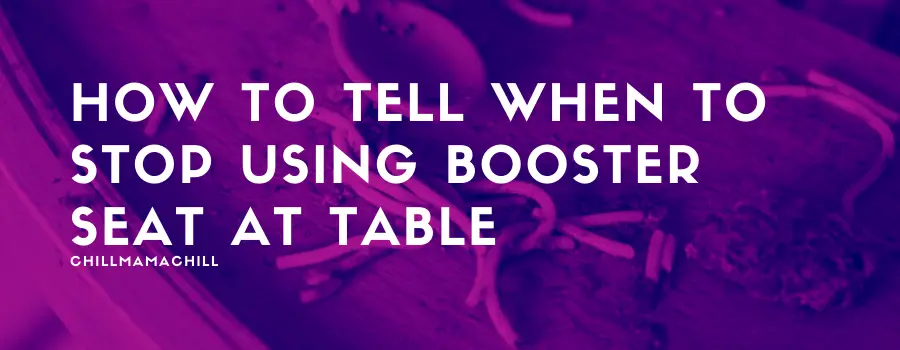It’s a memorable occasion when your child graduates from their high chair to seating at the dining table. So, how do you know when to stop using a booster seat at the table, and at what age is your child ready to sit directly on dining chairs?
Booster seats are meant to give your toddler the security and aesthetics that enable them to develop excellent dining table etiquette. Considering that babies are different in developmental capacities, you can stop boosting their seating from three to five years. If your child shows no signs of proceeding from supported seating, it’s not uncommon to use boosters up to the age of eight and beyond.
To avoid frustration and the ups and downs of chaos during mealtimes, keep reading for tips on stopping using a booster seat at the table.
Importance of Transitioning Your Child from a High Chair to a Booster Seat at the Dining Table
The excitement is palpable; your baby has completed their graduation of sitting in the dining chair, essentially completing your family’s mealtime arrangements. Your child is yearning for more independence, trying on big kid things like booster-less chairs.
But their safety, age, and your family’s dining etiquette are factors to consider before stopping the use of a booster seat at the table. On transitioning from a high chair, you’ll have to discourage them from kneeling, jumping, or standing on the table. Such antics will affect their eating habits.

Don’t let go of either the high chair or booster seat unless your child is entirely ready for the transition. If, at this point, you fail to set them on a straight path, it’ll be difficult to relearn the rules as they grow older. Consistency is crucial, especially when it’s about eating at the table despite the tantrums and meal disruptions you might endure.
Guidelines to Consider Before Moving Your Child from a Booster Seat to Regular Dining Chairs
Booster seats are designed for unassisted seating. They come in handy when your child stops using a high chair and moves to the dining table. You can use them between eighteen months to over five years of age. They can be strapped in regular chairs or standing alone.
A portable booster seat is helpful when you don’t have age-appropriate seating, like visiting with friends and family or on vacation.
When buying a booster attachment, it’s essential to consider whether you’re looking for a regular and sturdy at-home seat. You can also use one for when you’re on the move. A portable chair should be lightweight and folds easily, preferably with its carrier bag.
Safety Precautions When Choosing a Booster Seat for Your Child
Check the seat’s recommended weight or age limit. You can also find one that’s adjustable to a variety of your child’s developmental stages as well as table heights. Such a chair will be of service from when your tot is a baby until past their pre-school years.

Other safety considerations include;
- Check that the seat is assembled correctly and complies with standards by the Consumer Product Safety Commission. There’s also the ASTM, and the Juvenile Product Manufacturers Association’s standards.
- Ensure that your dining table is heavy for a hook on the booster seat, sufficient not to tip over when supporting your child’s weight.
- Avoid attaching the booster seat in a way your child’s feet touch the dining tables supports. Otherwise, they’ll push against these to dislodge their support seating.
- Double-check or test that your booster seat locked securely onto the dining chair or table. Thats before putting your child on the booster seat.
- Use the safety straps. That includes the middle strap between your child’s legs if your seat has a three-point harness. That’s to prevent slip-outs and falls.
- The dining chair to which you’ll attach a booster seat must be sturdy, heavy, and stable with a backrest. Avoid using a bar stool or folding chair.
- Never leave your child strapped in the booster seat. When unstrapped, don’t allow them to stand or kneel on it to avoid tipping over.
When Can You Stop Using the Booster Seat at the Table for Your Child?
Healthy dining for your child includes eating pleasantly, trying new foods, and keeping still until a meal is through. However, part of your itinerary will consist of knowing whether or not to stop using the booster seat at the table. If your kid is showing interest in sitting directly on the dining chair, it’s time for a final transition.
A rule of thumb is to stop once they’re old enough to follow dining etiquette rules. The booster seat could also start becoming cumbersome. You’ll know your child is ready when they reach their utensils without the extra support and require minimal supervision during mealtimes.
If your child is tall and comfortable dining without the height and protection offered by a booster seat, it’s time to sit on the traditional dining chair. Start with unstrapping your kid, allowing them freedom from restraints. A strap-free situation also means that ground rules must be laid and learned if you’re to proceed to the next phase.
These rules include consistently eating at the table and staying seated until the meal is over. When your child insists on coming down the booster seat, make them understand they won’t be getting back until the next mealtime.
Another rule is no toys or books at the table during meals. That’s a battle worth fighting before you can stop using the booster seat. Such distractions will not only prevent your child from effective eating while causing obstructions at the table, but they may also cause accidents. If they understand and follow through on these rules, you can remove boosting altogether.
Conclusion
Your child will give you all the signals they’re waiting for when to stop using the booster seat at the table. That’s the last remaining limitation towards self-feeding independence. You may be unprepared to transition to regular dining chairs, but they’ll keep insisting.
For the healthy development of your kid’s social functions, you can say goodbye to your child’s booster seat. Your child will be looking to copy adults or older children, following your queue when it’s time to sit on regular dining chairs.

I’m Cathrine and I’m a 39-year-old mother of 3 from Utica, New York. And I’m extremely happy you’ve come to visit my hide-out on the web. Here I post about everything related to family-life and usually it will involve babies and lessons I’ve learned over the years from experts, friends, and my own mistakes. So hopefully you will find what i write fun and informational!

